
(Click on any image below for a larger version)
Friday, January 26: Drake Passage
The next morning, the Drake Passage was not as smooth as it had been on our cruise southward. Winds measuring Force 6 on the Beaufort scale had generated a swell of fifteen-foot tall waves.
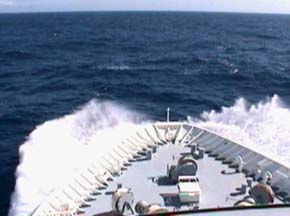 The ship was
running with the prevailing swell, so it gently pitched forward
and aft. Seasickness affected more of the passengers than it had
earlier in the voyage.
The ship was
running with the prevailing swell, so it gently pitched forward
and aft. Seasickness affected more of the passengers than it had
earlier in the voyage.
With nowhere to land, there was time for a series of lectures during our day at sea. Don Walsh presented the first lecture of the day. He was in the Navy and has a remarkable amount of submersible experience. He was aboard the Trieste when it was the first submersible to reach the bottom of the Marianas Trench in the early sixties.
A Bavarian buffet was served up in the Explorer Lounge that day. It featured many varieties of pickled herring, hot and cold German potato salads, sausages, and a roast pig.
Don Wilson of the Smithsonian Institute presented the final lecture of the day. He entitled it Out of Antarctica - Mammalian Radiations. His premise was that most mammal families derived from ancestral mammals on the great southern continent of Gondwanaland. He showed slides of representatives of each mammalian family and discussed the location of the origin of the earliest members of each. He went into extensive detail about the various families of bats. He seemed to have a particular fondness for bats.
Saturday, January 27: Cape Horn, Puerto William
The sky was overcast on Saturday morning when we arrived that the Islas Diego Ramirez, about sixty miles south of Cape Horn. The wind was blowing hard and kicking up a high swell, eliminating any chance of making a Zodiac landing on the islands. Rockhopper Penguins frequented the water around the ship and a few South American Fur Seals porpoised through the swells. A Chilean outpost on the largest of the islands was barely visible through the mist.
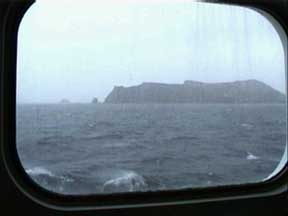 I
observed the scenery through our stateroom window most of the
time that day. I did not brave the cold, wet weather on the
observation deck at all.
I
observed the scenery through our stateroom window most of the
time that day. I did not brave the cold, wet weather on the
observation deck at all.
The ship continued to make its way through heavy seas to Cape Horn. We arrived at the cape in the early afternoon.
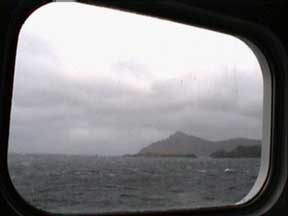 The winds were blowing 45 miles per
hour as we rounded the cape. If we had been in a sailing ship, we
would have been doomed to crash on the rocks, which have been the
site of uncountable shipwrecks. Just for the fun of it, Captain
Notke turned the ship around in a circle and rounded the cape a
second time.
The winds were blowing 45 miles per
hour as we rounded the cape. If we had been in a sailing ship, we
would have been doomed to crash on the rocks, which have been the
site of uncountable shipwrecks. Just for the fun of it, Captain
Notke turned the ship around in a circle and rounded the cape a
second time.
Turning the ship in a circle had the effect of rotating the direction from which the prevailing waves were striking us. First the ship was pitching back and forth with the waves coming from behind. Then it was rolling from side to side as the waves hit us broadside. Then we were pitching again, this time much more quickly as the waves came at us bow on. We went through another phase of more rolling and finished off with the ship pitching. Rest assured that the seasick passengers had a special appreciation for that second passage around Cape Horn.
The buildings of the Cape Horn outpost were visible on the crest of a ridge. If we did get to land at Cape Horn, we would have to make a long climb up a wet, wooden stairway to get to the top of the cliff.
A Chilean Navy boat pulled up alongside the ship to offload a local pilot, as required by Chilean law. The navy boat pitched and rolled erratically as the pilot struggled to step across to the Hanseatic. The two boats smacked together repeatedly in the swells.
The winds actually picked up force as the ship entered what should have been a sheltered anchorage. The gale was blowing force 9 on the Beaufort scale. It was gusting to sixty miles per hour. The ship couldn't even drop anchor in the rough seas, so we continued our cruise up the Beagle Channel to Puerto William, Chile.
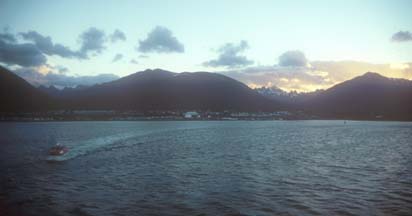 The ship
arrived at Puerto William and dropped anchor as we were
dining.The ship's tender shuttled passengers to the landing.
The ship
arrived at Puerto William and dropped anchor as we were
dining.The ship's tender shuttled passengers to the landing.
Sunday, January 28: Ushuaia
 The Hanseatic docked at Ushuaia
early in the morning on Sunday, January 28. We had time for a
leisurely breakfast buffet in the Marco Polo Restaurant before we
disembarked. The ship's staff and lecturers were waiting at the
bottom of the gangway to shake our hands as we exited the ship. I
made a point of distributing my web site cards with promises to
post some of the pictures I had taken on the expedition. We
boarded a trio of buses for the short ride over to the airport.
The Hanseatic docked at Ushuaia
early in the morning on Sunday, January 28. We had time for a
leisurely breakfast buffet in the Marco Polo Restaurant before we
disembarked. The ship's staff and lecturers were waiting at the
bottom of the gangway to shake our hands as we exited the ship. I
made a point of distributing my web site cards with promises to
post some of the pictures I had taken on the expedition. We
boarded a trio of buses for the short ride over to the airport.
| Buy an 8.3" x 44" panoramic print of this photo from the Lockett Photography Store for $33.00. They are on printed on Epson premium glossy photo paper using fade resistant Epson Ultrachrome inks: |
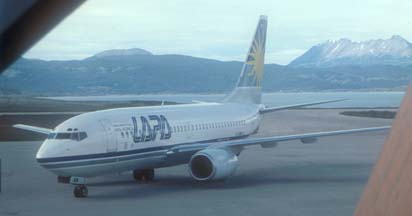 We boarded this LAPA 737-700. Our plane departed Ushuaia at about
10:00 A.M. local time. That is equivalent to 5:00 A.M. in
California. We landed in Los Angeles about twenty-seven hours
later.
We boarded this LAPA 737-700. Our plane departed Ushuaia at about
10:00 A.M. local time. That is equivalent to 5:00 A.M. in
California. We landed in Los Angeles about twenty-seven hours
later.
 South With Endurance
: Shackleton's Antarctic Expedition 1914-1917 is
available from
South With Endurance
: Shackleton's Antarctic Expedition 1914-1917 is
available from![]()
 Table of
Contents
Table of
Contents  Send
a message to Brian.
Send
a message to Brian.